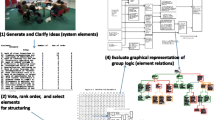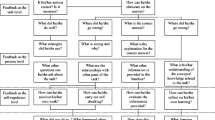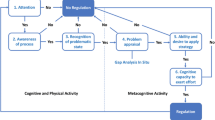Abstract
The current study compared the effects of open versus closed group dynamics on perceived consensus, objective consensus, and perceived efficacy of collaborative learning in participants high and low in dispositional trust in the context of an Interactive Management (IM) session. Interactive management is a computer-mediated collaborative tool designed to enhance group problem-solving by facilitating cooperative inquiry and consensus. In the current study, two groups of 15 undergraduate psychology students (N = 30) came together to structure the interdependencies between positive and negative aspects of social media. After screening for trust scores, participants high and low on dispositional trust were randomly assigned to either an open or closed voting condition. The closed voting group were not permitted to discuss the problem relations, but consensus votes were recorded by the group design facilitator. The open group were allowed to discuss the relations before voting. Results indicated that those in the open-voting group, and those in the high dispositional trust group, scored significantly higher on perceived consensus and perceived efficacy of the tool itself. Results are discussed in light of theory and research on collaborative learning.
Similar content being viewed by others
References
Ada W. W. (2009) Computer supported collaborative learning and higher order thinking skills: A case study of textile studies. Interdisciplinary. Journal of E-Learning and Learning Objects 5: 145–167
Alavi M., Wheeler B. C., Valacich J. S. (1995) Using IT to reengineer business education: An exploratory investigation of collaborative telelearning. MIS Quarterly 19(3): 293–312
Bohm D. (1996) On dialogue. Routledge, London
Broome B. J. (2004) Reaching across the dividing line: Building a collection vision for peace in Cyprus. Journal of Peace Research 41(2): 191–209
Currall S. C., Judge T. A. (1995) Measuring trust between organizational boundary role persons. Organizational Behavior and Human Decision Processes 64: 151–170
Fawcett L. M., Garton A. F. (2005) The effect of peer collaboration children’s problem-solving ability. British Journal Of Educational Psychology 75: 157–169
Flowers M. L. (1977) A laboratory test of some implications of Janis’ groupthink hypothesis. Journal of Personality and Social Psychology 35(12): 888–896
Fredrickson B. L., Losada M. F. (2005) Positive affect and the complex dynamics of human flourishing. American Psychologist 60: 678–686
Holden, R. K. (1990). An exploratory study of trust in buyer-seller relationships. Unpublished doctoral dissertation, Boston University
Janssen J., Kirschner F., Erkens G., Kirschner P. A., Paas F. (2010) Making the black box of collaborative learning transparent: Combining process-oriented and cognitive load approaches. Educational Psychology Review 22: 139–154
Jarvenpaa S. L., Knoll K., Leidner D. (1998) Is anybody out there? The implications of trust in global virtual teams. Journal of Management Information Systems 14: 29–64
Johnson, D. W., Johnson, F. P., & Stanne, M. (2001). Cooperative learning methods: A meta-analysis. Retrieved September 29, 2010, from http://www.tablelearning.com/uploads/File/EXHIBIT-B.pdf.
Kanawattanachai P., Yoo Y. (2002) Dynamic nature of trust in virtual teams. Journal of Strategic Information Systems 11: 187–213
Kenny D. A., Albright L., Malloy T. E., Kashy D. A. (1994) Consensus in interpersonal perception: Acquaintance and the big five. Psychological Bulletin 116: 245–358
Kenworthy J. B., Miller N. (2001) Perceptual asymmetry in consensus estimates of majority and minority members. Journal of Personality and Social Psychology 80: 597–612
Klein J. D., Pridemore D. R. (1992) Effects of cooperative learning and need for affiliation on performance, time on task, and satisfaction. Educational Technology Research and Development 40: 39–47
Kreijns K., Kirschner P. A, Jochems W. (2002) The sociability of CSCL environments. Educational Technology and Society 5(1): 8–22
Marsh, S., & Dibben, M. R. (2005) Trust, untrust, distrust and mistrust—an exploration of the dark(er) side. In Proceedings of international conference on trust management, pp. 17–33.
Mayer R. C., Davis J. H., Schoorman F. D. (1995) An integration model of organizational trust. The Academy of Management Review 20(3): 709–734
Mevarech Z. R., Kramarski B. (2003) The effects of metacognitive training versus worked-out examples on students’ mathematical reasoning. British Journal of Educational Psychology 73: 449–471
Mohammed S., Ringseis E. (2001) Cognitive diversity and consensus in group decision making: The role of inputs, processes, and outcomes. Organizational Behavior and Human Decision Processes 85: 310–335
Nichols J. D. (1996) The effects of cooperative learning on student achievement and motivation in a high school geometry class. Contemporary Educational Psychology 21: 467–476
O’Donnell A. M., O’Kelly J. (1994) Learning from peers: Beyond the rhetoric of positive results. Educational Psychology Review 6: 321–349
Parks C., Henager R., Scamahorn S. (1996) Trust and reactions to messages of intent in social dilemmas. Journal of Conflict Resolution 40(1): 134–151
Peterson R. S. (1997) A directive leadership style in group decision making can be both virtue and vice: Evidence from elite and experimental groups. Journal of Personality and Social Psychology 72(5): 1107–1121
Pearce, J. L., Sommer, S. M., Morris, A., & Frideger, M. (1992). A configurational approach to interpersonal relations: Profiles of workplace social relations and task interdependence. Graduate School of Management, University of California, Irvine.
Prinsen F. R., Volman M. L. L., Terwl J. (2007) Gender-related differences in computer-mediated communication and computer-supported collaborative learning. Journal of ComputerAssisted Learning 23: 393–409
Roberts K., O’Reilly C. (1974) Measuring organizational communication. Journal of Applied Psychology 59: 321–326
Rocco, E. (1998). Trust breaks down in electronic contexts but can be repaired by some initial face-to-face contact. In Proceedings of SIGCHI human factors in computing systems (pp. 496–502). New York: ACM Press.
Smith J. B., Barclay D. (1997) The effects of organizational differences and trust on the effectiveness of selling partner relationships. Journal of Marketing 61(1): 3–21
Stahl G., Koschmann T., Suthers D. (2006) Computer-supported collaborative learning: An historical perspective. In: Sawyer R. K. (Ed.), Cambridge handbook of the learning sciences. Cambridge University Press, Cambridge, UK
Warfield J., Cardenas R. (1994) A handbook of interactive management. Iowa State University Press, Ames
Warfield J. N. (2006) An introduction to systems science. World Scientific, Singapore
Author information
Authors and Affiliations
Corresponding author
Rights and permissions
About this article
Cite this article
Harney, O., Hogan, M.J. & Broome, B.J. Collaborative learning: the effects of trust and open and closed dynamics on consensus and efficacy. Soc Psychol Educ 15, 517–532 (2012). https://doi.org/10.1007/s11218-012-9202-6
Received:
Accepted:
Published:
Issue Date:
DOI: https://doi.org/10.1007/s11218-012-9202-6




